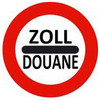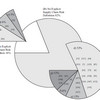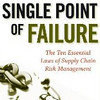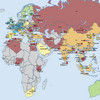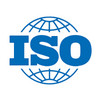 It is not often that I come across papers with a holistic view of the supply chain as a living and dynamic system. However, the introductory chapters of Architecture for supply chain analysis and methodology for quantitative measurement of supply chain flexibility, a 2001 PhD thesis by Wei Deng Solvang, explore the topic of supply chains having a typical 5-phase life cycle. I find that highly interesting. Not only is a supply chain a network of interlinked actors, but the links (or relations, if you so wish) are constantly changing, with new ones appearing and old ones dissipating.
It is not often that I come across papers with a holistic view of the supply chain as a living and dynamic system. However, the introductory chapters of Architecture for supply chain analysis and methodology for quantitative measurement of supply chain flexibility, a 2001 PhD thesis by Wei Deng Solvang, explore the topic of supply chains having a typical 5-phase life cycle. I find that highly interesting. Not only is a supply chain a network of interlinked actors, but the links (or relations, if you so wish) are constantly changing, with new ones appearing and old ones dissipating.
Mission, scope and life cycle
In her thesis, Solvang describes a supply chain as having three characteristics: a mission, a scope and a life cycle.
The mission, she says, is 3-fold: a) maximize customer satisfaction b) minimize (supply chain) operator expenditures and c) balance customer requirements with operator costs.
The scope can be narrow or broad, depending on the analyst’s point of view. The first scope is the classic supplier to customer straight line view. The second scope is the organization and structure of the supply chain, looking at its members and how they interlink. The third scope is the geographical dispersal, as in local/regional versus global. A fourth scope is simply physical, looking at suppliers and customers, and dividing them according to their distance (1st, 2nd 3rd tiers and so on) from the focal company.
The life cycle of a system normally has three stages: initiation, operation and cessation. The first part brings the system into being and deals with questions of how to design, structure and develop the system. The second stage deals with operational issues, how to manage, maintain, support and upgrade the system, and so on. The third part steps in when the system is no longer needed or obsolete, and deals with how to retire, replace or deplete the system.
Supply chain life cycle
Solvang expands on this view and applies it to the supply chain. In a collaborative paper, Deng et al. (2000) identify 5 phases in the supply chain life cycle: 1) identification of business opportunity, 2) selection of business partner, 3) formation of the supply chain, 4) operation of the supply chain, and 5) reconfiguration of the supply chain. This is a repetitive cycle. For every new business opportunity or product line these phases spring into action, thus creating a living and dynamic supply chain.
In short, a supply chain life can be separated into three stages: 1) formation, 2) operation and 3) extinction. Each step is critical to the next step, even extinction is critical to the next formation and the overall success for the supply chain and the overall continuity of the business. With steadily shortened product life cycles, increasing market volatility, and currently, swift changes in the global economy, a successful supply chain is a supply chain that is able to respond both dynamically and appropriately to the constantly changing challenges it is facing.
Related ideas
Solvang’s view on supply chains has much in common with what is known as Virtual Enterprise Networks (VENs), as described in The Networked Enterprise by Ken Thompson or in The Agile Virtual Enterprise by Ted Goranson, let alone in Creative Destruction by Nolan and Croson. Here, companies and supply chains have various stages throughout their life cycle, e.g. Thompson describes VENs as bioteams or groups that exhibit the characteristics of a living system. Using an ant colony as example, Thompson contends that bioteams have four stages: 1) Founding stage, 2) Ergonomic stage, 3) Reproductive stage, and 4) Terminal stage. Nolan and Croson describe six stages of “creative destruction”, where companies first, downsize and reorganize themselves to re-emerge as a reborn entity, often quite different from the original.
Reference
Solvang, W D (2001) Architecture for supply chain analysis and methodology for quantitative measurement of supply chain flexibility. PhD Thesis 2001:69, NTNU Trondheim, Norway.
Deng Z, Solvang B, Solvang W D (2000) Collaboration and Co-ordination of Virtual Supply Chain via Electronic Networking. Proceedings of 16h IFIP World Computer Congress, Beijing Hope, August 21-25, 2000.
Author links
- researchgate.net: Wei Deng Solvang
Related
- husdal.com: Book Review: Creative Destruction

